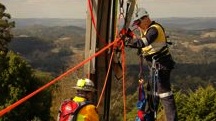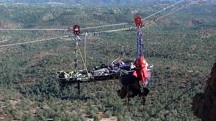Emphasis is places on "why" we do something, rather than "how". Students, as a team unit, learn how to build seemingly complex arrangements for reaching, treating and extricating a patient from the vertical high angle environment whether in industrial locations or in the wilderness. All the while, emphasis is placed on building everything from the basic materials most teams will have along: rope, carabiners, pulleys, accessory cord, webbing and know how. Specialised equipment, while certainly handy and interesting, is discouraged in this rigging-intensive course. Some rescuers also feel that an intermediate-level program should include highlines.
The IIC includes an extensive lecture and practical section on alternatives to highlines in the form of "offsets". Ropes That Rescue has become known for it's projection of these offsets as an alternative to training intensive highlines in the past 10 years. Offsets employ standard high angle techniques that most rescuers already know and so are more forgiving in the training curve than more elaborate systems.
The IIC is not by any means a beginning rope rescue program. It is a serious venture and complete immersion into rescue systems that can sometimes be overwhelming to some less experienced practitioners.
IIC key points:
• Safety factors / Safety margins
• Strong emphasis on team-oriented skills
• Knotcraft
• Intermediate pulley systems (simple through complex)
• Physics of rope rescue
• Artificial high directions:
Gin pole monopods
A frames
Sideways A frames
Easel A frames
• Directionals and anchor angle force calculations
• Batwing compound pulley systems
• Complete AZTEK kit orientation for team operations:
Belays and self belays
Dynamic fixed brakes
Dynamic directionals
Personal travel restrict and fall protection
• Mid face attendant-based and team-based litter scoops
• Belays, self belays, conditional belays and conditional self belays
• Focused and focused-floating anchors using opposition anchors
• Hot and cold changeovers
• Non-highline solutions to rescue scenarios
• Offsets for the high angle evacuation:
Tag and guiding line offsets
Deflected offsets
Tracking line offsets
Two rope offsets
• Much more....
Note: This is not a beginner’s course; it is aimed at rescue professionals who wish to increase their level of knowledge



